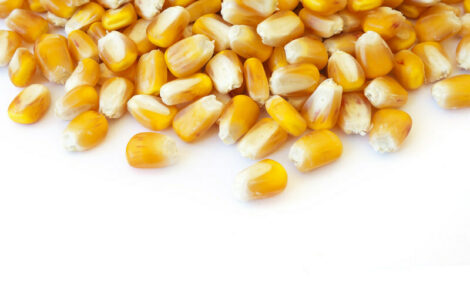



What Are The Key Performance Indicators of the Future?
Ron Ketchem of Swine Management Services (SMS) offered advice to delegates at the 2013 London Swine Conference on improving measures such as the number of litters per sows and year, litters per mated female, weaning to first service interval, farrowing rate, total piglets born, piglet survival and sow mortality.
Introduction
Swine Management Services, LLC (SMS) over the last few years has developed a Farm Benchmarking database that has grown to 800+ farms with 1.41+ million sows. Farms range in size from 200 to 10,000+ sows with most being independent pork producers. Data is obtained from 24+ different record programmes and 16+ different genetics companies represented. Tables 1 and 2 are summaries of data ending 2012. It is very interesting to us to see the variation in production levels from farms with range of fewer than 15 to more than 30 pigs weaned per mater female per year with 16 farms at 30+ pigs the last 52 weeks.
The author has been tracking production numbers since 2005 with the pigs weaned per mated female per year average going from 21.28 to 24.31 for a +3.03 pigs and the Top 10 per cent going from 24.72 to 28.60. Pigs weaned per female weaned from 9.17 to 10.55, with the Top 10 per cnet weaning 11.77.
Table 1. SMS performance data - 52-week average - 2012 summary
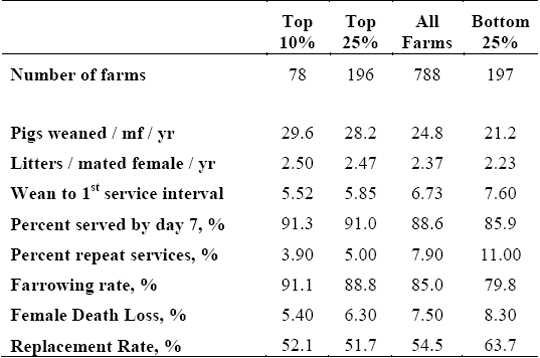
What are some of the Key Indicators that drive increased pigs weaned per mated female per year?
The dash board from the SMS Farm Benchmarking data base (Figure 1) shows the Key Indicators we look at to improve Pigs Weaned per Mated Female per Year: Litters / Mated Females / Year, Wean to 1st Service Interval, Pigs Weaned / Female Farrowed, Female Death Loss, Farrowing Rate, Total Born / Female Farrowed, and Piglet Survival.
Table 2. SMS performance data - 52-week average - 2012 summary
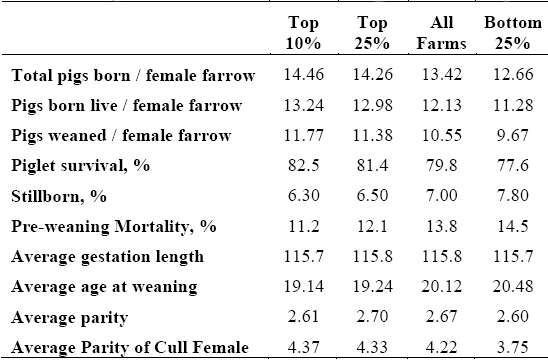
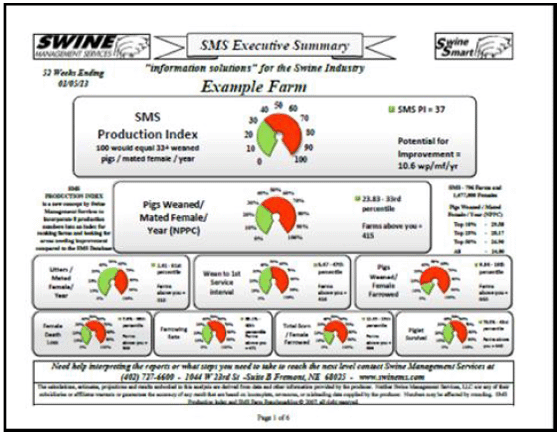
Litters per Mated Female per Year
Litters per mated female per year have a biological top of 2.60 litters. Assume farrowing rate at 100 per cent, 116 days of gestation, + 19 days of lactation + 5 days wean to first service = 140 days divided into 365 days = 2.60 litters. This means there are no repeats and cull sows are removed from records at weaning day.
In Table 1, the average is at 2.37 litters with Top 10 per cent at 2.50 and Bottom 25 per cent at 2.23 litters. The key numbers that affect this number are farrowing rate, weaning age, wean to first service interval and farrowing interval.
Suggestions on how to improve litters per mated female per year:
- review breeding procedures to improve farrowing rate
- start heat checking 14 days after breeding
- improve heat and pregnancy checking to find 60+ per cent of returns by day 25 of gestation
- consider a visual pregnancy check day 70-80 of gestation to find more the late returns sooner.
Wean to First Service Interval
In Table 3 is data from 602 farms that wean over 20 pigs per mated female. The farms are sorted by wean to first service interval.
As you see in the Table, the lower wean to first service interval influenced pigs weaned per mated female, percent bred by day 7, percent repeats, farrowing rate and total pigs born. The trend line for the SMS data base has been a drop in average days for weaned sows to cycle starting in early 2011. The author feels this is probably due to more farms increasing feed intake in lactation with more farms going to automated feed drop systems or feeding females more times per day.
Table 3. 602 farms over 20 pigs weaned per mated female per year – ranked by wean to first service interval
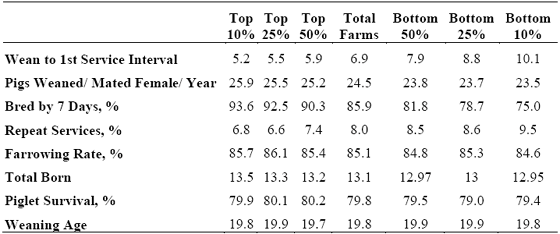
Suggestions for lowering wean to first service interval:
- feed sows more aggressive in farrowing starting day one of farrowing
- feed sows as individual with feed hopper or reservoir in farrowing
- feed weaned sows extra feed from weaning until bred (flushing)
- start daily boar exposure the day sows are weaned
- start heat checking sows the day after weaning and breed sows in heat, do not skip
Farrowing Rate
Farrowing rate is a three-part variable: Female × Semen × Breeder (AI Technician).
If each variable is at 90 per cent, the farrowing rate will be about 73 per cent. If you improve farrowing rate by four per cent, production will improve by about 1.35 pigs per sow per year.
In Table 4, a set of 603 farms that were sorted by farrowing rate to see if farrowing rate is a key indicator. You see farms with farrowing rate at 90+ per cent weaned 26.10 pigs per mated female per year versus <75 per cent at 20.40 pigs.
The trend lines for improvement in farrowing rate for all farms was 5.4 per cent starting in 2005 at 79.7 per cent and going to 85.1 per cent in 2012. The Top 10 per cent farms had farrowing rate in 2012 at 90.4 per cent.
Table 4. Farms sorted by farrowing rate ( per cent)
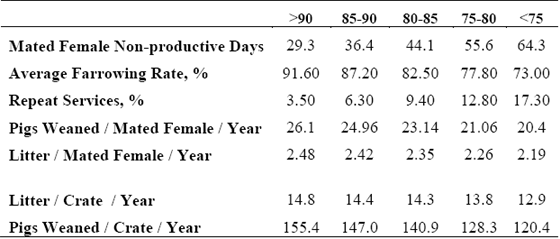
Suggestions to improve performance of breeder (AI technician):
- provide training and oversight/supervision
- take planned breaks to prevent fatigue
- record all mating information by AI technician including time of day (01-24 military time), and semen batch number
- fine-tune breeding procedures for each farm based on records broken down by number of services and matings, wean to first service interval, parity, day of week and hour breeding and semen batch number.
Suggestions to influence semen quality:
- at semen delivery, record batch information for evaluation later
- using temperature gun to check temperature of semen bags on outside and inside of bag for differences in temperature
- record daily Hi/Low temperatures of semen cooler for monitoring fluctuation in temperature which should be less than 2-3 degrees in 24 hours
- temperature setting for semen storage cooler temperature based on extender being used by semen provider
- rotate semen at least once per day
- arrange storage of semen by delivery date so older semen is used up first
- place semen storage unit in an air conditioned room at about 70 degrees F in hot weather and keep warm in winter
Total Born per Female Farrowed
Trend lines for the last eight years for total pigs born for an average farm was from 11.70 to 13.37 pigs with a gain of 1.67 pigs with Top 10 per cent farms went from 12.41 to 14.47 pigs for 2.06 more pigs.
A most influential number is total born for first-litter gilts. The first litter total born for gilts sets the potential for lifetime production. So to get P1 female off to a good start, replacement gilts need to have at least one recorded skip heat before breeding and if possible, spent at least 14+ days in gestation crate pre-breeding. In farms the author works with, gilts with at least one skip-heat have 0.20 to 1.0 more pigs on their first litter.
Suggestions on how to increase total pigs born:
- genetics: using F1 females
- gilts development: skip heats, crate exposure, 300+ pounds
- increase feed intake in lactation
- increase feed intake from weaning till breeding (+2.0 lb. per day)
- lower wean to 1st service interval
- more stimulation at breeding of female by Breeders (AI technicians)
Piglet Survival
SMS created a new formula a few years ago to more accurately measure piglet survival in farrowing. Instead of looking at stillborns per cent and pre-weaning death loss per cent separately, they were combined them with a formula of 100 per cent - (stillborn per cent + pre-weaning death loss per cent) = Piglet survival.
They look at stillborn and pigs that die as potential live born pigs. There are farms for a 52 weeks period at <67 per cent with a few farms now at 90+ per cent.
Table 5 shows the farms at 30+ pigs figured out the extra pigs are in the farrowing area they just needed to figure out how to save them with stillborns at 4.50 per cent and pre-weaning mortality at 7.30 per cent putting them at 88.2 per cent.
For the last eight years, the SMS data base showed piglet survival percent peaked in 2007 at ALL at 80.2 per cent and Top 10 per cent at 84.5 per cent. Since then, as total born has improved, piglet survival has declined some and has been flat the last few years with average in 2012 at 79.9 per cent and Top 10 per cent at 82.0 per cent.
Suggestions to improve piglet survival:
- extend farrowing hours to address stillborns (having someone attending sows farrowing for 18 hours per day (5am to 10pm) will allow them to attend 87.9 per cent of the farrowings
- reduce chilling of pigs by towel-drying or coating with drying agents at birth. Normal rectal temperature of pigs at 102+°F at birth, pigs that are not dried within five to 10 minutes loose 4+ degrees of body heat and will take 90+ minutes to get up to normal body temperature.
- define the job responsibility for day 1 person
- split suckle pigs first day of life
- plan for managing fall back pigs days 2-8
- euthanise small pigs
- carbon dioxide chamber for euthanising pigs in farrowing
- promoting “People Save Pigs”.
Female Death Loss
In the SMS database 2012, sow death loss at an average of 7.5 per cent with Top 10 per cent farms at 5.4 per cent and the Bottom 25 per cent farms at 8.3 per cent.
Sometimes there is an effect of female death loss on production numbers. A change of one per cent in female death loss can influence pigs per sow per year by 0.25 pigs. So lowering female death loss by four per cent equals 1.0 more pigs per sow per year.
The author suggests you look at female death loss by parity to see where the deaths are coming from. You may be surprised to see a very high percentage are younger females.
Table 5. SMS performance data - 52 weeks from 493 Farms - 2012 summary of farms with minimum of 20 pigs weaned per mated female
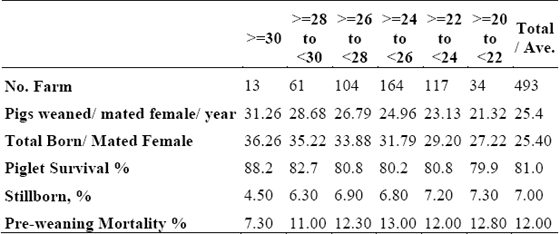
Suggestions to lower female death loss:
- improve training of crew on how to spot sick or lame females
- have written SOPs for how to handle and treat sick and lame females
- have your farm veterinary provide a list of what antibiotics to treat sick females with and stated withdraw times
- record detailed information on each treated female and keep for 12 months (PQA Plus)
- have someone accountable for treatment records and doing the euthanising of problem females
Conclusions
In conclusion, how well is your farm doing compared to the SMS database? What key indicators do you need to work on?
Can you and your staff make some changes that may be out of your comfort zone?
If you improve pigs weaned per mated female per year by one pig, you can lower your cost to raise a weaned pig by $1.60 per pig.
Further Reading
You can read other papers from the 2013 London Swine Conference by clicking here.
August 2013







